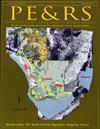Three-Dimensional Point Cloud Analysis for Building Seismic Damage Information
IF 2
4区 地球科学
Q4 GEOGRAPHY, PHYSICAL
引用次数: 0
Abstract
Postearthquake building damage assessment requires professional judgment; however, there are factors such as high workload and human error. Making use of Terrestrial Laser Scanning data, this paper presents a method for seismic damage information extraction. This new method is based on principal component analysis calculating the local surface curvature of each point in the point cloud. Then use the nearest point angle algorithm, combined with the data features of the actual measured value to identify point cloud seismic information, and filter the points that tend to the plane by setting the threshold value. Based on the statistical analysis of the normal vector, the raw point cloud data are deplanarized to obtain the preliminary results of seismic damage information. The density clustering algorithm is used to denoise the initially extracted seismic damage information. Ultimately, we can obtain the distribution patterns and characteristics of cracks in the walls of the building. The extraction result of the seismic damage information point cloud data is compared with the photos collected at the site, showing that the algorithm steps successfully identify the crack and shed wall skin information recorded in the site photos (identification rate: 95%). Point cloud distribution maps of cracked and shed siding areas determine quantitative information on seismic damage, providing a higher level of performance and detail than direct contact measurements.建筑震害信息的三维点云分析
震后建筑震害评估需要专业的判断;但是,存在高工作量和人为错误等因素。本文提出了一种利用地面激光扫描数据提取地震震害信息的方法。该方法基于主成分分析,计算点云中各点的局部表面曲率。然后利用最近点角算法,结合实际测量值的数据特征,识别点云地震信息,并通过设置阈值过滤出偏向平面的点。在法向量统计分析的基础上,对原始点云数据进行去平面化处理,得到震害信息的初步结果。采用密度聚类算法对初始提取的震害信息进行去噪处理。最终得到建筑物墙体裂缝的分布规律和特征。将地震损伤信息点云数据的提取结果与现场采集的照片进行对比,表明算法步骤成功识别了现场照片中记录的裂缝和棚壁表皮信息(识别率为95%)。裂缝和棚壁区域的点云分布图确定了地震损害的定量信息,提供了比直接接触测量更高水平的性能和细节。
本文章由计算机程序翻译,如有差异,请以英文原文为准。
求助全文
约1分钟内获得全文
求助全文
来源期刊

Photogrammetric Engineering and Remote Sensing
地学-成像科学与照相技术
CiteScore
1.70
自引率
15.40%
发文量
89
审稿时长
9 months
期刊介绍:
Photogrammetric Engineering & Remote Sensing commonly referred to as PE&RS, is the official journal of imaging and geospatial information science and technology. Included in the journal on a regular basis are highlight articles such as the popular columns “Grids & Datums” and “Mapping Matters” and peer reviewed technical papers.
We publish thousands of documents, reports, codes, and informational articles in and about the industries relating to Geospatial Sciences, Remote Sensing, Photogrammetry and other imaging sciences.
 求助内容:
求助内容: 应助结果提醒方式:
应助结果提醒方式:


